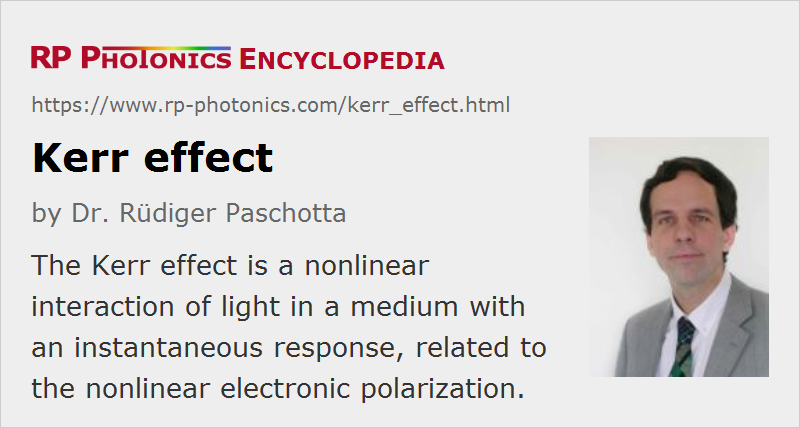Kerr Effect
Definition: a nonlinear interaction of light in a medium with an instantaneous response, related to the nonlinear electronic polarization
More general term: optical nonlinearities
German: Kerr-effekt
Categories: nonlinear optics, physical foundations
How to cite the article; suggest additional literature
Author: Dr. Rüdiger Paschotta
The Kerr effect is a nonlinear optical effect which can occur when light propagates in crystals and glasses, but also in other media such as gases. It can be described as a change in refractive index caused by electric fields, and being proportional to the square of the electric field strength. It comes in two different forms, which are explained in the following sections.
Kerr Electro-optic Effect (DC Kerr Effect)
In this context, one considers a slowly varying electric field, which is applied to some medium, e.g. to a piece of glass using two electrodes. A light beam passing the glass can then experience a polarization-dependent change of optical phase which is proportional to the square of the voltage applied to the electrodes, i.e., to the square of the electric field strength. The polarization dependence implies that birefringence is induced even in an optical material which is naturally not birefringent. Subsequently, the considered piece of glass could be used as an electrically controllable waveplate.
Assuming a constant electric field strength over some path length L, the field-induced phase change is
where Δn is the difference in refractive index between two polarization directions (parallel and perpendicular to the electric field direction), K is the Kerr constant of the material and E is the applied electric field strength.
Particularly large values of the Kerr constant are found for some polar liquids such as nitrotoluene and nitrobenzene, where molecules can be oriented by the applied electric field. Such liquids, filled into glass cells, are called Kerr cells.
The Kerr electro-optic effect is generally quite weak compared with the Pockels effect, where the refractive index changes are proportional to the electric field strength, rather than its square. The Pockels effect is exploited in Pockels cells.
Optical Kerr Effect (AC Kerr Effect)
Another variant of the Kerr effect occurs without an externally applied electric field, based on the electric field of a light wave only. The Kerr effect is the effect of an instantaneously occurring nonlinear response, which can be described as modifying the refractive index. In particular, the refractive index for the high intensity light beam itself is modified according to
with the nonlinear index n2 and the optical intensity I, which is proportional to the modulus squared of the electric field strength. The n2 value of a medium is related to the third-order susceptibility χ(3) and can be measured e.g. with the z-scan technique. Note that in addition to the Kerr effect (a purely electronic nonlinearity), electrostriction can significantly contribute to the value of the nonlinear index [3, 4]. The electric field of light causes density variations (acoustic waves) which themselves influence the refractive index via the photoelastic effect. That mechanism, however, occurs on a much longer time scale and is thus relevant only for relatively slow power modulations, but not for ultrashort pulses.
Fused silica, as used e.g. for silica fibers, has a nonlinear index of ≈ 3 × 10−16 cm2/W. For soft glasses and particularly for semiconductors, it can be much higher, because it depends strongly on the band gap energy. The nonlinearity is also often negative for photon energies above roughly 70% of the bandgap energy (self-defocusing nonlinearity).
The time- and frequency-dependent refractive index change leads to self-phase modulation and Kerr lensing, for different overlapping light beams also to cross-phase modulation. Note that the effective refractive index increase caused by some intense beam for other beams is twice as large as that according to the equation shown above, assuming that both beams are in the same polarization state.
The description of the optical Kerr effect via an intensity-dependent refractive index is actually based on a certain approximation, valid for light with a small optical bandwidth. For very short and broadband pulses, a deviation from this simple behavior can be observed, which is called self-steepening. It reduces the velocity with which the peak of the pulse propagates (i.e. it reduces the group velocity) and thus leads to an increasing slope of the trailing part of the pulse. This effect is relevant e.g. for supercontinuum generation. Furthermore, the strength of the Kerr effect is known to saturate at very high optical intensities.
At extremely high optical intensities, there may not be a further increase of refractive index in proportion to the intensity, but a saturation and even substantial decrease of refractive index [5]. This can be understood as an effect of multiphoton ionization, leading to induced losses, which are related to additional phase changes via Kramers–Kronig relations [7, 8].
A nonlinear polarization with delayed (non-instantaneous) response cannot be simply described as a modification of the refractive index. Its effect is called Raman scattering, and is not considered to be part of the Kerr effect.
Questions and Comments from Users
Here you can submit questions and comments. As far as they get accepted by the author, they will appear above this paragraph together with the author’s answer. The author will decide on acceptance based on certain criteria. Essentially, the issue must be of sufficiently broad interest.
Please do not enter personal data here; we would otherwise delete it soon. (See also our privacy declaration.) If you wish to receive personal feedback or consultancy from the author, please contact him e.g. via e-mail.
By submitting the information, you give your consent to the potential publication of your inputs on our website according to our rules. (If you later retract your consent, we will delete those inputs.) As your inputs are first reviewed by the author, they may be published with some delay.
Bibliography
| [1] | R. H. Stolen and A. Ashkin, “Optical Kerr effect in glass waveguide”, Appl. Phys. Lett. 22, 294 (1973), doi:10.1063/1.1654644 |
| [2] | M. Sheik-Bahae et al., “Dispersion and band-gap scaling of the electronic Kerr effect in solids associated with two-photon absorption”, Phys. Rev. Lett. 65 (1), 96 (1990), doi:10.1103/PhysRevLett.65.96 |
| [3] | E. L. Buckland and R. W. Boyd, “Electrostrictive contribution to the intensity-dependent refractive index of optical fibers”, Opt. Lett. 21 (15), 1117 (1996), doi:10.1364/OL.21.001117 |
| [4] | E. L. Buckland and R. W. Boyd, “Measurement of the frequency response of the electrostrictive nonlinearity in optical fibers”, Opt. Lett. 22 (10), 676 (1997), doi:10.1364/OL.22.000676 |
| [5] | V. Loriot et al., “Measurement of high order Kerr refractive index of major air components”, Opt. Express 17 (16), 13429 (2009), doi:10.1364/OE.17.013429 |
| [6] | D. N. Schimpf et al., “Circular versus linear polarization in laser-amplifiers with Kerr-nonlinearity”, Opt. Express 17 (21), 18774 (2009), doi:10.1364/OE.17.018774 |
| [7] | C. Brée, A. Demircan and G. Steinmeyer, “Saturation of the all-optical Kerr effect”, Phys. Rev. Lett. 106 (18), 183902 (2011), doi:10.1103/PhysRevLett.106.183902 |
| [8] | B. Borchers et al., “Saturation of the all-optical Kerr effect in solids”, Opt. Lett. 37 (9), 1541 (2012), doi:10.1364/OL.37.001541 |
| [9] | E. Fedulova et al., “Kerr effect in multilayer dielectric coatings”, Opt. Express 24 (19), 21802 (2016), doi:10.1364/OE.24.021802 |
| [10] | G. P. Agrawal, Nonlinear Fiber Optics, 4th edn., Academic Press, New York (2007) |
See also: Kerr lens, optical phase, self-phase modulation, cross-phase modulation, nonlinearities, nonlinear index, group velocity, Raman scattering
and other articles in the categories nonlinear optics, physical foundations
 |





If you like this page, please share the link with your friends and colleagues, e.g. via social media:
These sharing buttons are implemented in a privacy-friendly way!